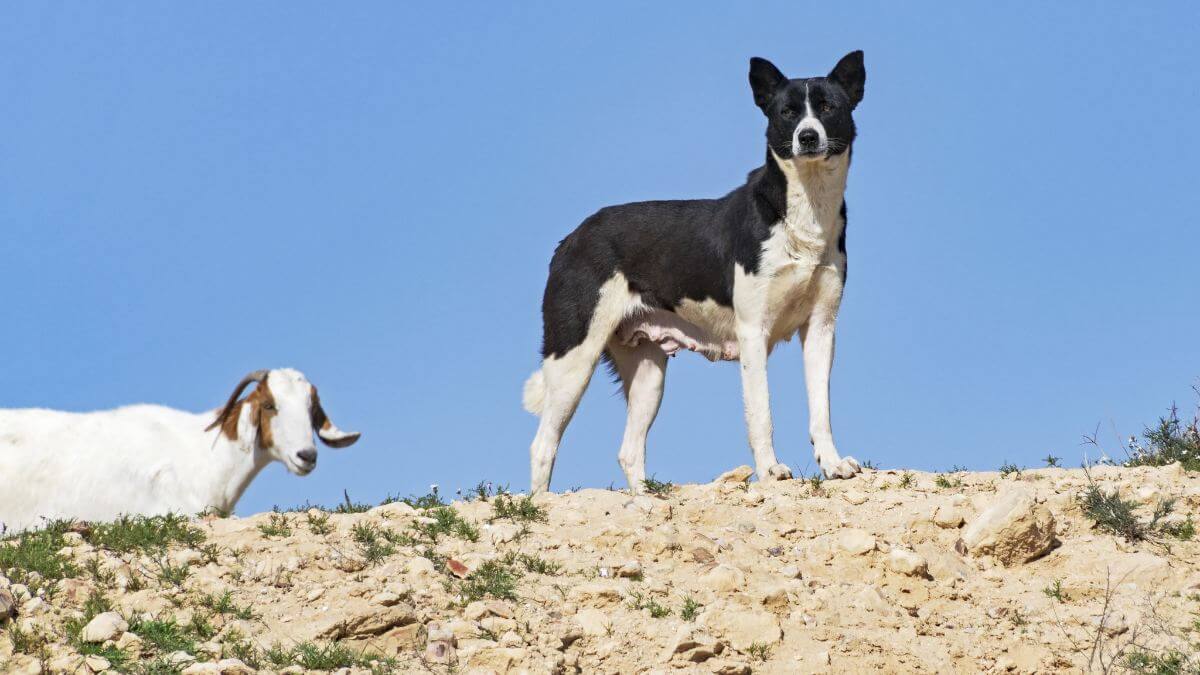This article was originally published in Showsight Magazine, February 2013 issue.
Oh My! There is a Canaan Dog in My Ring!
Not everything you have heard about the Canaan Dog is true. They are not feral beasts that would rather bite you than look at you. Quite the opposite is true. They would much rather flee from a situation than face confrontation.
The past decade has seen vast improvements in temperament in the ring. This improvement is due to breeders improving temperament, more experienced handlers, positive ring experience, and proper socialization of the dogs. Granted, there is always room for improvement, and there are a few things you can contribute to this improvement.
There are many key things you can do in your ring to set a wary or inexperienced Canaan Dog at ease. If you have judged sighthounds, you should have no trouble with a Canaan Dog in your ring. This breed is very alert and in tune with its surroundings. They are naturally aloof with strangers but have a strong desire to please their handler.
- Allowing the entry to gait around the ring once prior to examination is the first key thing you can do. This allows the entry to become familiar with its surroundings. It also gives the inexperienced handler a moment to settle down.
- Please allow a bit of time for the handler to stack their entry. Try to avoid direct eye contact with the entry during this time. Once the entry is stacked and ready, approach with confidence – not dominance. It is best to approach at an angle – not directly from the front or side, and NEVER from the rear.
- Once within close proximity, it never hurts to exchange pleasantries with the handler. This helps the entry realize its handler is comfortable with your proximity, and thus, the dog should be comfortable as well. This can also ease a nervous handler, in turn relaxing the entry.
- The first contact with the entry, assuming the entry is relaxed and you are comfortable, should be a gentle hand under the chin. This allows the entry to feel unthreatened. A few kind words to the entry, and a gentle scratch at this juncture, can go a long way with this breed.
- Do not be taken aback if the handler asks to present the bite to you. This should not reflect on your opinion of the entry’s temperament. There are many well-tempered Canaan Dogs that just don’t like strangers in their mouth. This could stem from a bad experience as a puppy or other factors. If you are going to examine the bite, please take care not to cover the entry’s eyes during your inspection.
- With most Canaan Dogs, once you get past the initial approach and head examination, the rest is a piece of cake. You may find a Canaan Dog turning its head to watch you complete your exam. Please do not take this head turn as an act of aggression. Most experienced handlers will gently hold the muzzle while you examine the rest of the body.
- While examining the body, use a firm but not heavy touch. This is another opportunity for kind words and gentle scratches to reassure the uneasy entry. Try not to hover or lean over the dog during your exam, as this could make the dog feel cornered or trapped. As with any breed, males don’t like cold hands on their nether regions, and females can act a little silly when they’re in season.
What should you do with an unruly Canaan Dog in your ring?
First, please try to assess if it’s really the entry or an inexperienced handler. If you feel the handler is a novice and the entry is not aggressive or overly shy, please take a moment or two to guide and mentor. As we are not a popular or populous breed, we find we recruit many first-time dog show folks. A gentle word and a good experience will bode well for our sport. If you truly have an aggressive or overly shy entry that you cannot examine, you MUST excuse the entry. The excusal of extreme improper temperament is something that must be done. Most handlers will be hurt and embarrassed by the excusal, so if you can, please offer a kind word.
Canaan Dogs, especially young ones, are very impressionable and never forget. A positive ring experience will leave a lasting impression—such is also true for the opposite. Please take those couple of extra moments to provide a positive experience.
As a testament to those who have worked hard to improve the temperament and image of the Canaan Dog in our sport: the well-trained, socialized, and well-handled Canaan Dog will be a joy to have in your ring.
Top 10 Things to Look for in a Canaan Dog (in no particular order):
- Blunt wedge-shaped head: The head should appear as a blunt wedge when viewed in profile and from above. There should be no appearance of a two-piece head. The cheeks should be smooth with adequate fill under the eyes.
- Hooded ears, set low, and almond-shaped eyes: Both ear lobes’ edges should curve markedly forward. Almond-shaped eyes are basically oval and bluntly pointed at both corners.
- Square body: The body should be square, measured from the point of shoulder to the rearmost projection of the upper thigh and from the withers to the ground.
- Effortless movement: The trot should be quick and brisk, covering more ground than expected. An endurance trot, as opposed to tremendous reach and drive, is required.
- Moderation and soundness: Moderate angulation should result in soundness.
- Nobility and grace: A noble presence and graceful movement should be evident in this breed.
- Curled tail: When excited, the Canaan Dog’s tail should curl over the back. One full curl is desired, but a sickle tail is acceptable. The tail should not curl more than once or fall off to the side like an Akita’s.
- Alert and watchful: The Canaan Dog is very alert and aware of its surroundings. They don’t miss anything happening in their environment.
- Flat-lying coat: Harsh, flat-lying, double coat of short to medium length. Undercoat should appear according to the season. Feathering present on the neck and thighs. Open coats are undesirable as they are ineffective in the elements.
- Naturalness: This breed has survived for thousands of years on the fringe of civilization. Their keen senses and survival instincts have allowed them to thrive in these conditions.



